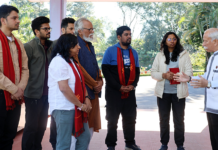Flights Of Fantasy
[ M Panging Pao ]
Today, 21 November, marks the official end of the 1962 Sino-India war. This war was a black chapter in India’s history. Many Arunachalee veterans and old-timers recall the war with fear and anger. Chinese forces entered deep into Arunachal along many axes, namely, the Tawang-Bomdila-Rupa, the Taksing-Limeking, the Mechuka/Manigong-Tato, the Gelling-Tuting and the Kibithoo-Walong axes. Though the Chinese forces penetrated without major opposition in many axes, many fierce battles were fought by a few units and small groups of soldiers.
The 1962 Sino-India war was fought in Ladakh in the western sector and in Arunachal in the eastern sector. By the end of the 31-day war, Chinese forces had penetrated about 100 kms inside Arunachal, reaching Rupa-Chaku, just 20 kms short of the Assam border. Along the Taksing-Limeking axis, Chinese forces entered 60 kms inside and crossed Limeking in Upper Subansiri district. Similarly, Chinese forces entered 50 kms inside the Mechuka/Manigong-Tato axis and reached Tato in Shi-Yomi district. Likewise, Chinese forces reached Tuting along the Gelling-Tuting axis and occupied Walong in Anjaw district.
During the war, many fierce battles were fought by both sides in both sectors. About 22,000 Indian troops faced much superior Chinese troops, numbering about 80,000. As per Chinese reports, Indian forces suffered 5,000 killed or wounded and 4,000 captured against Chinese casualties of 722 killed and 1,700 wounded. However, as per Indian reports India lost 1,383 soldiers, 1,047 wounded, 1,700 missing and 3,968 captured against 1,300 Chinese soldiers killed.
Even after the Sino-India war of 1962, there have been regular clashes along the Sino-India border, including at Nathu La in 1967, Sumdorong Chu in 1987, the 73-day Doklam confrontation in 2017, Chinese incursions in Asaphila, Tuting and Chaklagam areas of Arunachal in 2017-2018, and the recent violent conflicts at Pangong Tso Lake and Galwan Valley in Ladakh in 2020. Tense situation exists all along the India-China border.
China occupies a majority of Aksai Chin in Ladakh, claims Arunachal Pradesh as ‘southern Tibet’ and issues stapled visas to Arunachal citizens. They object to visits by senior Indian officials and ministers to Arunachal and use rivers originating in China to arm-twist India.
Considering China’s stance, India has ramped up defence infrastructure and preparedness all along the border over the last few decades and cannot be underestimated like in 1962. However, China is an emerging world superpower and is challenging even the USA.
India and Arunachal should learn from the debacle in the 1962 Sino-India war and cannot afford similar mistakes both militarily and strategically. Being a frontline state, Arunachal is directly affected. Like in 1962, the security pundits/leadership sitting in New Delhi should not take decisions about faraway Arunachal and Ladakh in isolation. The only way to counter the Chinese threat is by expediting infrastructure development like key roads, railways, bridges, airfields, fuel/ammunition depots, hardened shelters, etc, along the India-China border. We need to learn and adopt Chanakya Niti. (The contributor is retired Group Captain, Indian Air Force)




